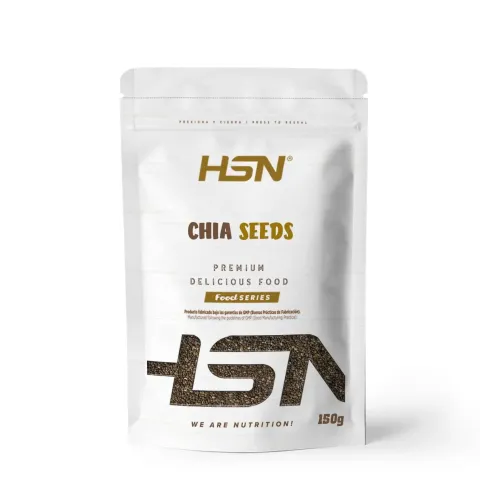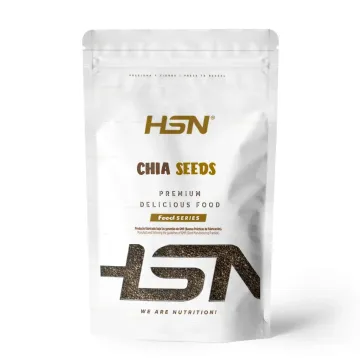- Authentic Chia Seeds: Top nutritional quality in a natural way. 0% additives.
- Source of protein and high in healthy fats: Chia seeds contain 18% protein and 84% of their fatty acids are unsaturated.
- Good for cholesterol: Alpha-linolenic acid, found in chia seeds, helps maintain normal blood cholesterol levels 1.
- Enjoy them your way: You can eat them raw, ground, toasted or soaked. Your choice!
- High fibre content: 34g of dietary fibre per 100g of seeds.
Chia Seeds: An ancient food for modern wellness
Chia Seeds from FoodSeries are a natural food made exclusively from the seeds of the chia plant (Salvia hispanica), with no additives or processing.
Chia is a seed from the Salvia hispanica L. plant, native to regions of Central America. Small and black in colour, it’s used in many diets for its versatility and nutritional value. It's a plant-based source of protein and contains a high amount of fibre and unsaturated fats, especially alpha-linolenic acid (omega-3). Thanks to its ability to absorb liquids and form a gel, it can be easily added to different preparations like smoothies, yoghurts, bread, etc.
If you're looking to enhance the quality of your dishes, don't miss HSN’s natural chia seeds.
Fibre, omega-3 and natural energy for you
High content of healthy fatty acids: Rich in omegas
Many foods we commonly eat are high in saturated fats, such as non-lean red meats. Other foods, like oily fish, are rarely consumed in Western diets, which is why foods like nuts and seeds are considered 'high-quality nutrition', because:
Replacing saturated fats with unsaturated fats in the diet helps to maintain normal blood cholesterol levels
(monounsaturated and polyunsaturated fatty acids are unsaturated fats).
Chia seeds are also rich in omega fatty acids, especially the original (plant-based) omega-3: Alpha-linolenic acid, which also helps maintain normal blood cholesterol levels 1.
34% Dietary fibre. Improve your diet
One of the most common uses for chia seeds is to mix them in water to form a fibre-rich gel.
This is possible because chia seeds are very rich in fibre, particularly the soluble type—notably mucilage and natural gums—which are responsible for forming a gel when soaked long enough.
Modern diets often lack sufficient fibre, as ultra-processed foods have become increasingly present in our daily meals, and they are typically made with highly refined carbohydrates, which are low in fibre. Chia helps restore proper fibre intake thanks to its high content, and as the fibre comes from seeds and not grains, it’s ideal for increasing fibre intake in Keto diets.
Plant-based source of protein (18g/100g)
High-quality plant-based protein sources are not common, and people following vegan diets or trying to reduce their consumption of animal-based foods often struggle to meet daily protein recommendations.
Proteins help maintain and increase muscle mass.
Chia seeds are a source of protein, providing 18 grams per 100 grams of seeds, which is considered a significant and highly relevant amount, especially for vegan diets.
Enjoy them however you like: Usage ideas
Chia seeds are easy to enjoy thanks to their versatility. They can be eaten raw, sprinkled directly onto salads, yoghurts, kefir, vegetable creams or protein shakes, adding a crunchy texture without changing the flavour. They can also be ground for better integration into bakery or pastry doughs (like breads and pancakes), or to aid the absorption of some nutrients. When lightly toasted, they develop a more intense flavour and can be used as a topping for cereals, homemade bars, or energy bowls.
Another popular way to consume them is soaked, as when mixed with water, plant-based drinks or juices, the seeds form a natural gel thanks to their soluble fibre. This allows for the preparation of puddings, compotes, sports-use gels, or even as an egg substitute in vegan recipes. They're perfect for overnight mixtures like 'overnight oats' or as a base for healthy desserts.
Their ability to adapt to both sweet and savoury dishes makes them a functional and creative ingredient for everyday cooking.
Recipe idea: Overnight Oats with Protein and Chia
Ingredients (1 serving):
Preparation:
- In a shaker with a lid, mix the oats, protein powder, chia seeds and cinnamon.
- Add the plant-based drink and mashed banana. Stir well until you get a smooth mixture.
- Close the container and leave it in the fridge for at least 4 hours, ideally overnight.
- The next morning, stir again and add your favourite toppings before eating.
Tips:
Take care of your diet with HSN
At HSN we offer a wide range of healthy foods, perfect for looking after your diet.
You can find them all in the 'Healthy eating' section on our website.
Bibliographic references
- Agnoli, C., Baroni, L., Bertini, I., Ciappellano, S., Fabbri, A., Papa, M., … Sieri, S. (2017). Position paper on vegetarian diets from the working group of the Italian Society of Human Nutrition. Nutrition, Metabolism and Cardiovascular Diseases, 27(12), 1037–1052.
- Khalid, W., Arshad, M. S., Aziz, A., Rahim, M. A., Qaisrani, T. B., Afzal, F., Ali, A., Ranjha, M. M. A. N., Khalid, M. Z., & Anjum, F. M. (2022). Chia seeds (Salvia hispanica L.): A therapeutic weapon in metabolic disorders. Food science & nutrition, 11(1), 3–16.
- Knez Hrnčič, M., Ivanovski, M., Cör, D., & Knez, Ž. (2019). Chia Seeds (Salvia hispanica L.): An Overview-Phytochemical Profile, Isolation Methods, and Application. Molecules (Basel, Switzerland), 25(1), 11.
- Ullah, R., Nadeem, M., Khalique, A., Imran, M., Mehmood, S., Javid, A., & Hussain, J. (2016). Nutritional and therapeutic perspectives of Chia (Salvia hispanica L.): a review. Journal of food science and technology, 53(4), 1750–1758.
- Marcinek, K., & Krejpcio, Z. (2017). Chia seeds (Salvia hispanica): health promoting properties and therapeutic applications – a review. Roczniki Panstwowego Zakladu Higieny, 68(2), 123–129.
- Melo, D., , Machado, T. B., , & Oliveira, M. B. P. P., (2019). Chia seeds: an ancient grain trending in modern human diets. Food & function, 10(6), 3068–3089.
1 The beneficial effect is obtained with a daily intake of 2g of this fatty acid.
 Before
Before After
After During
During Morning
Morning Afternoon
Afternoon Night
Night Before
Before After
After During
During Morning
Morning Afternoon
Afternoon Night
Night Before
Before After
After During
During Morning
Morning Afternoon
Afternoon Night
Night










